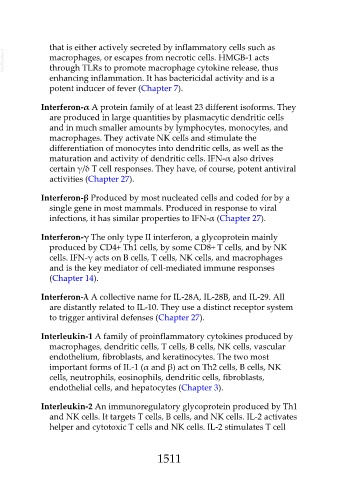Page 1511 - Veterinary Immunology, 10th Edition
P. 1511
that is either actively secreted by inflammatory cells such as
VetBooks.ir macrophages, or escapes from necrotic cells. HMGB-1 acts
through TLRs to promote macrophage cytokine release, thus
enhancing inflammation. It has bactericidal activity and is a
potent inducer of fever (Chapter 7).
Interferon-α A protein family of at least 23 different isoforms. They
are produced in large quantities by plasmacytic dendritic cells
and in much smaller amounts by lymphocytes, monocytes, and
macrophages. They activate NK cells and stimulate the
differentiation of monocytes into dendritic cells, as well as the
maturation and activity of dendritic cells. IFN-α also drives
certain γ/δ T cell responses. They have, of course, potent antiviral
activities (Chapter 27).
Interferon-β Produced by most nucleated cells and coded for by a
single gene in most mammals. Produced in response to viral
infections, it has similar properties to IFN-α (Chapter 27).
Interferon-γ The only type II interferon, a glycoprotein mainly
produced by CD4+ Th1 cells, by some CD8+ T cells, and by NK
cells. IFN-γ acts on B cells, T cells, NK cells, and macrophages
and is the key mediator of cell-mediated immune responses
(Chapter 14).
Interferon-λ A collective name for IL-28A, IL-28B, and IL-29. All
are distantly related to IL-10. They use a distinct receptor system
to trigger antiviral defenses (Chapter 27).
Interleukin-1 A family of proinflammatory cytokines produced by
macrophages, dendritic cells, T cells, B cells, NK cells, vascular
endothelium, fibroblasts, and keratinocytes. The two most
important forms of IL-1 (α and β) act on Th2 cells, B cells, NK
cells, neutrophils, eosinophils, dendritic cells, fibroblasts,
endothelial cells, and hepatocytes (Chapter 3).
Interleukin-2 An immunoregulatory glycoprotein produced by Th1
and NK cells. It targets T cells, B cells, and NK cells. IL-2 activates
helper and cytotoxic T cells and NK cells. IL-2 stimulates T cell
1511

